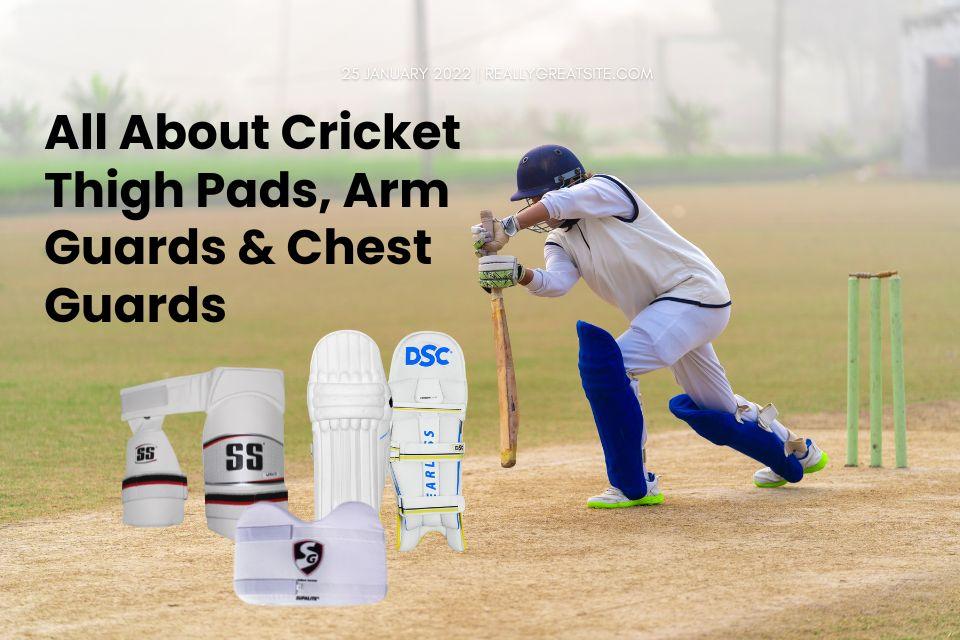


When it comes to cricket, everyone talks about bats, balls, and helmets. But what about the lesser-celebrated protective gear—thigh pads, arm guards, and chest guards? Are they a must for every player or just for pros facing express pace? Let’s break it down for beginners, casual players, and future stars alike.
Thigh Pads:
These Thigh pads are designed to shield the upper leg (thigh area) from impact. A well-placed bouncer or an inside edge can cause serious bruising or even injuries—thigh pads absorb that shock.
Arm Guards:
Placed on the leading arm, arm guards protect you from balls that rise unexpectedly, especially on lively wickets or against fast bowlers.
Chest Guards:
Worn under the shirt, chest guards cushion the ribs and chest area—an area exposed especially when facing short-pitched bowling or awkward bounce.
Protection from Injury: Fast bowlers can deliver at over 140 kmph. Even a glancing blow can hurt!
Confidence at the Crease: Knowing you’re protected allows you to focus on your game, not on the fear of injury.
Mandatory in Competitive Cricket: Many leagues and coaches insist on full protection, especially for youth and beginners.
Increasing Pace & Bounce: Modern bats and improved pitches have made the game faster—meaning protective gear matters more than ever.
If you are…
A Beginner or Casual Player:
It’s smart to use at least a thigh pad and arm guard. You might not face express pace, but even medium-pacers can surprise you.
Chest guards are optional at the recreational level but highly recommended if you’re nervous about short balls.
A Youth or Junior Cricketer:
Safety comes first! Coaches strongly recommend all protective gear for young players.
Developing good safety habits now builds confidence and reduces injury risk as you move up levels.
Facing Fast Bowling or Hard Pitches:
You absolutely need all three—thigh pad, arm guard, and chest guard. Injuries at higher speeds can be nasty and may keep you out of the game for weeks.
A Pro or Advanced Player:
All top players use these guards, especially when facing quicks. Even batters in T20 and Test cricket never skip their full set.
Fit:
Pads, guards, and chest protectors should fit snugly, not restrict movement, and stay in place as you run.
Material:
High-density foam and lightweight polycarbonate are best. Look for moisture-wicking linings to keep cool.
Adjustability:
Quality straps and ergonomic designs prevent slipping or discomfort.
Brand:
Trusted names like SG, SS, DSC, MRF, Shrey, and Kookaburra offer high standards for comfort and safety.
Budget:
There are options for all levels—don’t compromise on quality just to save a few bucks.
Wipe down gear after every use to remove sweat.
Air-dry in the shade; avoid direct sunlight for foam products.
Regularly check straps, stitching, and padding for wear and tear.
Thigh pads, arm guards, and chest guards aren’t just for the pros—they’re for anyone who loves cricket and wants to play fearlessly. Whether you’re smashing sixes, grinding it out in nets, or just starting out, the right protection means more time enjoying the game and less time nursing bruises.
So next time you kit up, don’t skip the small stuff—it might just save your match!
Want help picking the perfect set for your skill level?
Explore top-rated protective gear at SportsGear24x7 or reach out for expert advice!
Q1. Are these guards compulsory in club cricket?
Many clubs and coaches recommend them, especially for under-18 players. Rules vary, but safety is always the priority.
Q2. Can these guards affect my movement or batting style?
Not if they’re the right fit! Modern gear is designed to be lightweight and ergonomic, so you’ll barely notice them once you’re used to it.
Q3. Are all protective guards unisex?
Most are, but some brands offer guards shaped for female players as well.
Q4. How do I know when to replace my guards?
If you notice cracks, compressed padding, broken straps, or discomfort, it’s time for an upgrade.
Q5. Should bowlers and fielders use these guards?
Generally, only batters and close-in fielders use thigh, arm, and chest guards. Wicketkeepers have their own protective gear.